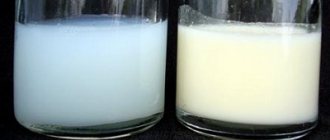Hundreds of articles have been written about the benefits of breastfeeding; in maternity hospitals and antenatal clinics, in courses for pregnant women, exclusively this method of feeding a child is promoted from birth to 6 months.
Scientists have not yet invented a composition that, in its properties, could become a full-fledged replacement for breast milk.
But what to do if mom doesn’t have enough milk? Often, this is a fictitious problem.
There are reliable signs by which you can determine milk deficiency.
You can measure the amount of milk by counting the baby's peees. While breastfed, the baby secretes only the fluid that it receives from the mother's breast. As a rule, one “pee” of a child is 30 ml. If the child relieves himself 12 times a day, the urine is of low concentration and does not have an unpleasant odor - we can talk about the sufficiency of breast milk and the mother does not need to worry. The second sign by which you can determine whether a mother has little milk is insufficient growth of the child. Weekly weight gain should be 125 grams.
If the child pees little and has insufficient weight gain, lactation must be restored. Correct breastfeeding, do not limit the child's sucking, do not give him a pacifier or water, and in 97% of cases this can be done.
But, nevertheless, having received reliable information about the insufficiency of breast milk, supported by obvious signs, the mother decided to stop breastfeeding.
Practical recommendations for weaning a child due to insufficient milk supply:
- Carefully monitor the development and mental state of the child during this period, since weaning when the baby is not yet ready can negatively affect his general condition;
- Limit fluid intake, which will lead to a gradual cessation of lactation and it will be difficult for the baby to suckle, as a result of which he himself will stop asking for the breast.
- Gradually reduce the duration and number of feedings, keeping the child busy with interesting activities.
- Avoid breast pumping completely.
- Remove fluid from the body. For example, playing sports helps.
- Avoid foods that stimulate milk production.
Let's summarize: the mother must put the child in a situation where breastfeeding becomes either difficult or not interesting for him. Be patient and understand that the baby will feel unsatisfied, since in his life before there was only one “sedative” - his mother’s breast, which he was deprived of.
If the baby has grown up and is ready for weaning, the mother will be able to distract him, will not feel pity, will be balanced and calm. Another thing is if the baby is small and unprepared, weaning is problematic. Often mothers leave for a while or try to hold the baby less. This is a wrong tactic: the child should feel that his mother loves him. It will be great if maximum time has passed from the moment of making the decision to gradually stop feeding until the last breastfeeding.
Signs that baby and mother are ready to wean
To complete lactation painlessly for mother and baby, you need to make sure that both are ready for weaning:
- The number of applications was reduced to 1-3 times a day. Daytime attachments are kept to a minimum, feedings are built around sleep: before falling asleep and after waking up;
- The child has a food interest, he eats complementary foods, tries to eat unfamiliar food from an adult plate;
- The baby is able to fall asleep on his own, does not need the breast to prolong sleep, moves from one phase of sleep to another without sucking;
- The baby does not use breastfeeding as a way to comfort and calm down in an uncomfortable situation;
- The mother’s milk supply has decreased, there is no pain, the breasts are soft, lactation is unstable;
- The mother is psychologically prepared for the end of lactation; she calmly accepts the fact that an important stage in the relationship with the baby is coming to an end;
- An important condition for a smooth weaning is the support of all family members.
Folk remedies to stop lactation?
To make it easier to endure the difficult period after breast tightening, it is recommended to use folk remedies. These products are best used from day one. They will help avoid swelling and pain:
- We drink an infusion of sage or mint. By volume - at least 500 ml;
- We reduce the volume of liquid to the optimal amount necessary to maintain vital functions;
- We apply a cabbage leaf to the chest, as well as other (but exclusively cold) compresses.
Using harmless folk remedies on time means eliminating the possibility of using hormonal drugs that are not particularly useful.
When is the best time to start?
There is no consensus on when it is best to start weaning a baby. According to WHO recommendations, breastfeeding is possible up to 2 years. But the decisive factor should be the opinion of the mother and the desire of the child. On average, breastfeeding lasts 1.5 years.
Until 5-6 months, the baby does not need any other food other than mother's milk. At 5 months, complementary foods are introduced and other foods appear in the diet. By 9 months, the child already receives 3 types of complementary foods; mother's milk makes up no more than 1/3 of his diet.
Milk production decreases in proportion to the decrease in the number of breastfeedings. It is recommended to wean when no more than 1-2 feedings are made per day, and they are at night.
Weaning should be done gradually; it is better to start with daytime feedings, as evening feedings help the baby fall asleep. You can express milk so that your baby receives it, but not from the breast, but from a bottle.
During weaning, you should not deprive the child of his mother’s attention for a long time so that he does not feel abandoned.
Tip 8: If feeding needs to be completed urgently, act delicately
It happens that a mother urgently needs to wean her baby from the breast. This may be due to pregnancy, forced long separation of mother and child, illness or treatment of the mother that is incompatible with breastfeeding. In this case, lactation must be stopped abruptly.
How to proceed? Express breasts when full until soft or relieved, but not completely. With each new pumping, milk will leave the breast. This will help avoid lactostasis and mastitis in the mother.
At this time, it is better to transfer the child to artificial feeding or give him expressed milk from a bottle, or finally transfer him to adult food.
During the completion of lactation, it is very important for the mother to demonstrate confidence in her actions, because a positive attitude is half the success!
- share with your friends!
Experts: Polina Petrovna Lykova
Follow us on Facebook:
How to stop breastfeeding in children of different ages
Completion of breastfeeding in children of different ages has its own characteristics. This is due to the physical and mental development of the child; in the first 2 years of life, the psycho-emotional sphere undergoes multiple changes, the attitude towards natural nutrition changes, based on which the weaning tactics should also be changed.
From birth to 6 months
At this age, breast milk is the main source of nutrients and immunoglobulins for the child; it will be difficult to refuse. If there are medical reasons not to breastfeed after childbirth, it is better not to start breastfeeding.
If it was carried out, then they are transferred to artificial mixtures. When there are 1-2 feedings left per day, the woman needs to take Dostinex and finally transfer the baby to formula.
From 6 to 18 months
At this age, complementary foods are introduced, the diet expands, and milk is no longer the only food for the child. There are fewer feedings - 2-3 per day. It is difficult to eliminate night feedings at this age; they are the key to restful sleep.
In this situation, pumping will save you - milk is poured into a bottle and given at night if the baby wakes up (dad can also feed from a bottle, mom will have time to sleep). Expressed milk can also be frozen.
From 18 months and older
If the child is older than one year, milk no longer has such nutritional value, and breastfeeding plays a predominantly psychological role - the opportunity to be with the mother and feel protected.
Here we need to make it clear that mother can express her love in a different way. During the day you need to hug the child, stroke him, play, and study.
Other family members can also put you to bed.
SOS: what to do with congested breasts after weaning
Every nursing mother comes to a point when she decides to stop lactation. There are several weaning techniques and the choice should depend on the specific situation. If the mother needs to start complex treatment or urgently go on a long business trip, then she will have to prepare for a difficult emergency weaning.
When the mother is close to the baby and has some time left, it will be easier to curtail lactation. Breastfeeding specialists give recommendations on how to wean a child correctly and quickly, and also not to “break the woods” in attempts to get rid of breast milk.
Feed reduction method
The most painless and gentle way to stop breast milk lactation is considered to be the method of reducing feedings. Most often, women choose ways to end breastfeeding that will be comfortable for the baby, and only then think about themselves. But the end of lactation should be as gentle as its beginning.
By the way, you can understand whether your child is ready for weaning with the help of our test.
The emotional and physical state of the mother is important for the baby, even if she is not breastfeeding. When finishing breastfeeding, the mother should also think about herself.
WHO recommends breastfeeding your baby until he or she is six months old. After this, the child is introduced to complementary foods, but breastfeeding continues. After a year, WHO recommends breastfeeding if possible, but it is at this age that more than 50% of women already want to say goodbye to breastfeeding. As a rule, the mammary glands are not yet ready for this, and mothers face difficulties.
The method of reducing feedings is that the mother gradually reduces the number of feedings. This can only be done after 6 months, since in the first six months breast milk is the only source of nutrition for the baby. It is better to start with daytime feedings. Gradually, the mother gives up one feeding, replacing it with completely normal food.
It will not be possible to stop breastfeeding abruptly without breast fullness. With gentle weaning, the baby's need for milk gradually decreases. Women's breasts quickly adapt to the new regime.
Already 3-4 days after giving up one feeding, the mother notices that her milk supply has decreased.
Using the method of reducing feedings, you can stop lactation without pills and without harm to your own health.
How many days does milk “burn out”?
With a gradual reduction in the number of feedings, the milk “leaves” naturally. It doesn’t “burn out” in one day. Sometimes you can hear from women that after illness and high fever, the milk “burned out” in one moment. This doesn't happen. Therefore, mothers who want to curtail lactation should not hope for a one-day miracle.
If you decide to stop breastfeeding, you need to be patient. After a year of lactation, gradual weaning will take 2-4 months. After two years, lactation winds down faster.
The mammary glands quickly adapt to new conditions. After weaning, since there is no demand for breast milk, it gradually ceases to be produced. It takes about 40 days for the breasts to stop filling.
Therefore, we can say that milk “burns out” 40 days after the last application. But when you press on the nipple, droplets will be released from it for about six months.
Therefore, a woman can resume lactation even after a long break.
How to alleviate your condition with folk remedies
Since most mothers try to curtail lactation before the baby is 2 years old, many have to face difficulties.
Even if lactation is stopped correctly, in the first days the breasts become full and milk reflexively flows out of the nipples in response to the baby’s crying. Sometimes lumps appear in the chest and even pain occurs.
GV consultants will help you cope with these problems, but if you don’t want to resort to the help of a specialist, you can use traditional methods.
Cold compresses
When a mother abruptly stops feeding, the breasts become overfilled with milk. With engorgement, swelling occurs due to stagnation of lymph. A cold compress will help to cope with it.
At home, you can apply a cool cloth or use special gel pads. Cold causes vasoconstriction and provokes lymph outflow. When using a compress, you must be careful not to overcool the tissue.
If you overdo it, a spasm of the milk ducts will occur and lactostasis will begin.
Herbal infusions
Grandmothers advise stopping lactation using folk remedies. To do this, they recommend drinking herbal infusions. Sage helps reduce milk production. The herb is a natural phytoestrogen and suppresses prolactin.
Herbs are considered a safe remedy, but it is better not to rely on them during breastfeeding. If the mother plans to continue breastfeeding the baby, then she needs to be more careful with herbal infusions.
Pumping until relief
Breastfeeding consultants recommend ending lactation no earlier than the child turns one year old. After a year, the mechanism of milk production changes, and it will be easier to reduce its amount. If your breasts become full, you can pump a little. You cannot use a breast pump or, especially, ask your husband for help. When expressing, there should be no stimulation of juices, otherwise the opposite effect will occur.
If the breast is full, you need to remove the milk only slightly. You can express a little. As soon as relief comes, you need to stop. If you express your breasts completely, it will be the same as regular breastfeeding. In this case, the child will wean off breastfeeding, but the mammary glands will not be able to adapt to the new regime.
Why are lactation pills not the best solution?
If a mother in the maternity hospital says that she does not want to breastfeed her baby, she will immediately be offered pills. Even gynecologists are confident that with their help you can quickly stop lactation and avoid unpleasant consequences. The drugs are called “breast milk” or “lactation” tablets. But in reality, medications have a different purpose.
Preparations to suppress prolactin are created for people who have health problems. These tablets are prescribed for endocrine disorders. Sometimes they are prescribed when planning a pregnancy, since high levels of prolactin do not allow conception. But this does not mean that the pills will help in all cases of infertility.
Same with breastfeeding. You cannot prescribe medications to all women without exception who want to stop lactation. In some cases, medications are indeed necessary.
But taking such pills must be agreed with your doctor, and taken only after examination.
If a gynecologist or mammologist indiscriminately prescribes a drug for lactation, it makes sense to consult with another specialist.
It’s even worse if a nursing mother decides to take medicine herself to stop breastfeeding. As a rule, this situation occurs already during mature lactation.
Anti-lactation pills are not the best solution because:
- The mother does not know how the baby will react to abrupt weaning. Often women cannot survive the suffering of their child, they give up and return to breastfeeding. It is dangerous after taking the pill.
- Drugs to suppress prolactin affect hormonal levels in general, not just the breasts. Inept use of pills leads to hormonal imbalances and serious illnesses.
- Lactation medications have strong side effects. Often, after one pill, a woman feels so bad that she simply cannot care for her child.
GV consultant Nina Zaichenko warns: “Such a crude drug intervention can lead to very unpleasant effects. To the point that these hormonal pills can have a bad effect on your next lactation with your next child. In civilized countries, such tablets are prohibited from free sale.
If the doctor prescribed an anti-lactation pill after a year of breastfeeding, it may not work. Few doctors follow the latest research in the field of breastfeeding, and few know that by the age of one year, breast milk is produced completely differently than after childbirth.
Therefore, such events may turn out to be useless and, moreover, harmful.”
What not to do
There are many myths surrounding GW. When a mother wants to finish breastfeeding, she looks for the easiest and fastest way.
Often inexperienced women turn to their mothers, grandmothers, and “experienced” friends for advice. It’s good if careless advisers give safe recommendations or even refuse to help a nursing woman.
It’s worse when grandmothers give harmful advice, following which the mother risks her own health.
Lactation consultants tell you what absolutely should not be done to complete breastfeeding. Experts try to warn nursing mothers, since most often they resort to dangerous and prohibited methods.
Breast drag
The most common method is dragging. This recommendation can be heard from representatives of past generations. Grandmothers say that it was by pulling that they managed to get rid of breast milk in a few days. They advise their children to do the same. But medicine has a different point of view on this problem.
Any mammologist will tell you that squeezing the breasts will not work to reduce lactation. Moreover, this method is very dangerous for women's health.
If at a young age a girl thinks that tugging does not lead to anything bad, then in the future she will inevitably have problems. It's only a matter of time. Tug-of-war has been known for a long time.
The essence of this method was that the woman tied her breasts with a scarf and showed the baby that there was no more milk. But the “refinement” of this weaning method now has a different mechanism of action.
Tightening compresses the milk ducts. The milk stagnates in them, and compactions appear.
If the mother of a two-year-old child, who produces milk once every three days, endures this manipulation without consequences, then the mother of a one-year-old baby will have lactostasis with a 90% probability.
When tugging, breast tissue is injured. Subsequently, this leads to inflammation (mastitis), mastopathy and the formation of benign tumors and even oncology.
Fasting and refusing water
More than half of women believe that to stop lactation it is necessary to reduce the amount of fluid consumed.
Consultants say: “Milk is formed from lymph and blood, but not from the contents of the plate and cup. Even in hungry Africa, women have milk. You need to reach some kind of severe exhaustion for the body to stop producing milk.”
Stopping breastfeeding has nothing to do with diet. By fasting and refusing to drink, a woman will not be able to stop the flow of milk. In these ways, she will only harm her health, but the baby will continue to receive all the beneficial substances from the mother’s body.
Source: //ProGrudnoe.ru/osnovy/kak-prekratit-laktaciyu.html
Optimal age for weaning
WHO recommends feeding the baby only breast milk for up to 6 months, gradually introducing complementary foods and ending breastfeeding after 2 years, and even later if the mother wishes.
Weaning before 1 year is still premature and unphysiological. A child needs breastfeeding, so he receives high-quality nutrition and immune protection, satisfies the sucking reflex, and is in close contact with his mother. Weaning at this age is stressful for the baby.
If breastfeeding is completed before one year, it will not be possible to saturate the child with complementary foods alone; you will have to introduce formula for feeding. During this period, complementary feeding is used as a way to stimulate food interest.
WHO recommends feeding the baby only breast milk for up to 6 months, gradually introducing complementary foods and ending breastfeeding after 2 years, and even later if the mother wishes.
GW after a year has its own characteristics:
- From 1 to 1.5 years is the most difficult period for weaning, because:
- the child needs the breast more strongly, because the process of psychological separation from the mother begins, which frightens the baby, he needs confidence and stability;
- The endless flow of information excites the nervous system, requiring the usual methods of calming in the form of breast sucking.
- From 1.5 to 2.5 years - Breast milk provides the energy needs of a child of 2 and 3 years of life by 30-50%, then he will be able to get enough of ordinary food.
At this age, children independently regulate the amount of milk they drink. The optimal age for completion is after 2 years; the older the child, the easier it is to wean him, negotiate with him and explain what is happening.
Some facts about breast binding
The principle of breast tightening to complete lactation is based on the fact that the mammary glands are compressed, which causes a reduction in milk production. But in fact, if a woman continues to lead her usual lifestyle, that is, drinks a lot of fluids, eats salty foods and does not take any medications or herbal remedies, the secretory lobules continue to function. At the same time, the milk passages become overfilled, the pressure increases, unexpressed milk stagnates, causing lactostasis, which, in turn, can lead to the development of mastitis. As for the latter, in particularly advanced forms it requires surgical intervention.
Since a woman has to walk for several hours with a bandage, blood circulation in the mammary glands is disrupted. This can lead to the appearance of cysts and even cancer. Conclusion: from a physiological point of view, breast pulling is useless, even dangerous.
According to WHO recommendations, feeding without contraindications should be continued for at least a year, and a maximum for up to 3 years.
In what cases is it allowed
From a medical point of view, the only justification for breast ligation is to reduce the amount of milk produced. In this case, the bandage is applied for a couple of hours a day.
There are three more cases in which breast ligation can be taken as a way to suppress lactation:
- a woman has an individual intolerance to drugs to reduce lactation;
- allergies to herbal supplements;
- a firm belief in the effectiveness of chest tightening.
If one of the described cases is yours, then you should familiarize yourself with the rules and subtleties of breast ligation.
Optimal time for weaning
You should only wean your baby if he is healthy, feeling well and gaining weight.
You should not end lactation at a time of sudden changes in life conditions: moving, vacation, parental divorce, adaptation to kindergarten.
They do not stop breastfeeding during a crisis of 3 years; there is no need to create additional stress for a three-year-old during this emotionally unstable period.
Do not stop breastfeeding in the summer, because... During this season, the risk of intestinal and infectious diseases is high. In addition, in summer the need for drinking increases, which the baby satisfies with milk.
How to wean a baby - important rules
- You should not suddenly stop breastfeeding. For the child this is fraught with psychological and neurological problems, for the mother - congestion in the mammary glands, mastitis and inflammation.
- It is important to develop a child’s food interest, teach him to drink clean water, and make sure he gets enough vitamins and nutrients from other foods.
- During the weaning period, it is necessary to strengthen physical contact, so the child gets the opportunity to feel his mother’s love in other ways: with hugs, kisses, stroking.
- Mother and child should spend more time together so that he does not feel abandoned. New joint rituals can be introduced.
- Don't be nervous or angry if you can't come to an agreement with your baby. It’s better to lie next to her and calm her down. During this difficult period, he needs support and attention.
Mom and baby need to spend more time together
Develop an interest in food
During the weaning period, it is necessary to increase physical contact
Natural ways
A woman’s body is designed in such a way that the amount of milk produced directly depends on how often the baby is put to the breast. Milk will gradually decrease if you feed your baby less often.
During the period of cessation of lactation, you need to express until you feel relief in your chest. You can't completely empty your chest .
If a woman feels a lump in the mammary gland, she needs to quietly express the breast completely so that the lump dissolves. This is necessary to avoid inflammation. It is strictly forbidden to apply warm compresses to the areas of compaction to prevent the formation of purulent mastitis.
Dr. Komarovsky explains whether it is necessary to feed a baby until a woman’s milk completely disappears and what breastfeeding experts advise:
Basic ways to wean a baby
To properly complete lactation, the following methods are used:
- Fairytale therapy. The mother tells the child fairy tales where the main characters experience the same situation as the baby. With the help of such stories, feelings and emotions are described, and solutions to problems are proposed. Mom makes it clear that the milk is running out, the breastfeeding process is coming to an end. It is important to explain what will happen next after you stop breastfeeding. It’s worth telling where the milk goes and why adult children don’t drink it. You can come up with a fairy tale yourself or buy special books with drawings.
- Replacing the breastfeeding ritual with new ones that will emotionally bring mother and child closer together: reading before bed, massage, lullaby, and other joint activities. If breastfeeding used to be the main way of interaction, now communication takes on a new form.
Gradual weaning
The main rule for stopping lactation is gradualism. An abrupt end will lead to a deterioration in the child’s sleep and appetite, neurological tics and obsessive movements, auto-aggression, setbacks in development, reduce trust in the mother and the world, and disrupt the harmony in relationships.
For children, breastfeeding is not just a way to get enough and satisfy basic physiological needs, but also a way of close intimate interaction with their mother, an opportunity to calm down, fall asleep, and feel protected and safe.
The mother’s task is to competently organize the daily routine in order to create conditions for gradual weaning:
- Introduce complementary foods according to age, use different foods, stimulate food interest, and let them try food from their plate.
- Always offer complementary foods first, and then breastfeeding; perhaps the baby will be satisfied with solid food only, without breast milk.
- Eliminate chaotic feedings, stick to main meals at the same time (breakfast, lunch, afternoon snack, dinner).
- Teach your child to fall asleep without breastfeeding and independently move from one phase of sleep to the next. To do this, you can contact a child sleep consultant.
- Show ways to calm and comfort without sucking, be there in difficult situations, support.
- Only if all conditions are met do they begin to curtail lactation. In this case, it will pass calmly and effortlessly.
The main stages of gradual weaning from the breast
- From 6 to 9 months, complementary foods are introduced, which supplement breastfeeding. The purpose of the stage is to introduce new tastes and textures, and not to feed the child. Food is cut into pieces, ground into purees, and bright vegetables and fruits are offered to increase interest in food. They offer water for drinking. Breast milk remains the main nutrition during this period.
- From 9 months to a year, the volume of complementary foods is increased, the child regulates food intake himself, trying to get enough of the new food. After complementary feeding, he does not always attach to the breast; solid food is enough for him. At this stage, it is important to listen to the child, not to feed or force him to eat.
- From the age of 1, the child goes to a common table with healthy, high-quality food. Complementary feeding gradually replaces breastfeeding. The mother's body produces less milk in accordance with the baby's needs.
- By the age of 2, the child independently refuses breastfeeding in favor of ordinary adult meals. He may not remember his mother’s breast for 2-3 days, then he will latch on again for a short time. A soft, independent, logical refusal of feeding occurs without harm to the nervous system of both participants.
How to transfer breast milk to stop lactation
Nature dictates that a mother breastfeed her baby for quite a long time. The longer this period is, the stronger the child’s immune system will become.
However, over time, breastfeeding ends, and the mother has the question of how to properly stop lactation so as not to harm her health and psychological trauma to the child.
Let's figure out how to transfer breast milk correctly.
Methods to stop breast milk production
Breastfeeding is beneficial for both the baby and his mother. This process has a positive effect on a woman’s hormonal background. There are methods in which cessation of lactation entails almost no discomfort. To suppress the synthesis of prolactin, you can use special medications or herbs.
How to gradually stop breastfeeding
The process of breastfeeding has certain stages, starting with its formation and ending with involution. The final period is carried out gradually.
Sometimes the decline in the synthesis of breast milk occurs before the baby turns 1 year and 2 months. A criterion for assessing the condition of the mammary glands will help you understand that involution has begun.
This period is characterized by a decrease in the production of prolactin, the breasts are soft all day long.
Gradually, when we finish the lactation period, we should leave only one night feeding. Of course, then you will need to give it up, but the baby will continue to have a sucking instinct for a long time. In order to satisfy it, it is recommended to feed the baby a dairy product, compote, or tea from a bottle.
Advice: To reduce the synthesis of milk, the mother should breastfeed less. Thus, the amount of milk will be produced in a smaller volume, based on the needs of the baby.
What are some ways to quickly finish feeding?
Many women are interested in how to stop breastfeeding quickly. However, it is important to understand that these methods are not humane. Most children find it difficult to understand that the time has come when they should stop sucking milk from their mother. Most often, the following methods are used for these purposes:
- Quite often, the baby is sent to the closest relatives for this time. It turns out that he has no contact with his mother for 2-3 days. This sometimes leads to serious stress for the baby, since the process of stopping feeding is associated with the feeling of losing the mother. In addition, a woman continues to synthesize milk as usual, and her risk of developing mastitis increases.
- To reduce milk, use tugging with an elastic bandage. Thus, you can stop lactation at home after 3 days. In this case, it is advisable to limit the consumption of hot drinks.
How to properly perform a chest tuck
Before you properly transfer breast milk, you should understand that this method causes a lot of physical discomfort for the mother.
If a woman decides to bandage, then she should use the help of loved ones to bandage it, since it is impossible to do this on her own.
First, the bandage is applied to the ducts that are located above the gland area; be sure to look at the photo and video for the correct bandage procedure.
For the first time, stretch for the night. The next day, it is recommended to briefly express milk from the bandaged breast. An indicator that it is time to stop pumping is the absence of discomfort and the elimination of chest pain.
If you express too much milk, then in this way you can only increase its synthesis. This procedure is often accompanied by fever, pain, and hardening of the breasts. If such symptoms appear, you should immediately consult a doctor.
Traditional methods to help stop lactation
Camphor wraps help stop feeding. They suppress lactation, restore the skin, and minimize the possibility of the formation of hardened areas.
First, it is recommended to soak the bandages in pre-warmed camphor oil. Then they need to be applied to the chest area, covered with cellophane on top, and put on underwear. This procedure should be carried out at night.
However, before putting on your underwear, it is important to remember that due to the strong smell of camphor, you will have to throw it away later.
Herbal infusions will help stop lactation, which can be used not only for internal use, but also for rubbing. The most widely used herbs are those with a diuretic effect, among them mint and sage are widely used. These products help to gradually reduce milk production. After just 7 days, the woman feels significant changes.
Before you stop breastfeeding, you can drink the following herbal decoctions:
Name of herb Method of preparation
| Sage | 10 gr. crushed leaf should be poured into 1/3 liter. boiling water Leave for 60 minutes. Drink in a day |
| Mint | 10 gr. pour ½ liter of leaf. boiling water, leave for 1 hour. Take three times a day |
| Lingonberry leaf | 10 gr. pour 1/3 liter of crushed leaf. boiling water Drink gradually throughout the day |
In what cases is drug cessation of lactation used?
It is highly undesirable to stop breastfeeding by taking medications. Because these methods can cause negative consequences for a woman’s health. They are usually used to abruptly stop feeding, for example, when returning to work or when doctors prohibit breastfeeding. Before using the tablets, you should consider the following recommendations:
- You can take medications only after consulting a doctor, after an examination. This will help avoid side effects from inappropriate medications.
- Medicines can only be taken if there is no time for other solutions.
- Before you start taking the pills, you should understand that it will be impossible to restore prolactin synthesis.
Advice from Dr. Komarovsky
Usually, the process of stopping breastfeeding is a serious stress not only for the child, but also for his mother. The transition to adult nutrition should not be abrupt.
However, it happens that a woman has health problems and loses the opportunity to breastfeed her baby. At the same time, milk continues to be released, discomfort occurs, accompanied by pain and bloating.
Therefore, in order to avoid problems with the question of how to stop lactation, Komarovsky, a famous pediatrician, gives recommendations on ending the breastfeeding process. First of all this:
- Limiting maternal fluid intake. This means that she should not force herself to drink more than was necessary during feeding.
- In addition, you should think about reducing the sucking time; you can distract the child during this period and offer him entertainment.
- There is no need to express milk.
- It is beneficial to exercise because less milk is produced when you sweat.
- You should not eat foods that stimulate the production of mother's milk.
- You can try to spoil the taste of milk, for example, by including garlic and onions in your diet.
Before finishing breastfeeding, Komarovsky advises not to eat soups, foods that cause increased water consumption.
Instead of tea, it is better to drink herbal decoctions that have a diuretic effect. Dr. Komarovsky recommends using decoctions of basil, lingonberry, horsetail, and elecampane. For this you need 1 tbsp. l.
pour 1 liter of herbs or herbal collection and drink throughout the day.
How to understand that a child is ready to stop breastfeeding
As a rule, babies tend to wean themselves off the breast. However, there are also those who find it difficult to give up this habit, but sooner or later the end of the lactation period will occur. The main thing is that both the baby and the mother have psychological readiness.
From the point of view of doctors, when to stop breastfeeding - Komarovsky claims that it is not difficult to understand that this time is approaching. Typically, the initial symptoms of involution begin to appear when the child reaches 1 year and 2 months. But this can occur earlier if a woman’s hormonal background changes.
The following signs will help you understand the readiness of the mother and baby for involution:
- Previously, mommy experienced only positive emotions from breastfeeding. Now emotional fatigue has replaced it. She feels discomfort in her chest;
- lack of discomfort for the mother during long intervals between feedings;
- The baby does not have enough breasts, he feels hungry and often asks for the breast.
Ending breastfeeding
So is it necessary to deny the baby the breast if these signs are present? Pediatricians say there is no need to rush into this. As the milk changes, it becomes similar in quality to the colostrum formed after the birth of the baby. This composition contains many antibodies and can protect the baby from infectious diseases for six months.
An important condition for ending breastfeeding is the necessary emotional state. The main thing is for the baby to understand that he is only being weaned, but not deprived of his mother’s love. During this difficult period, he should be given more attention and tenderness.
Source: //GrudyuKormi.ru/vskarmlivanie/prekrashchenie/kak-peretyagivayut-moloko.html
How to reduce lactation during gradual weaning
With gradual weaning, the mammary glands adapt gradually. Milk is produced according to the baby’s needs and within 2-3 days the body will reduce its quantity. With a soft completion, the breast is not expressed, it does not swell or harden.
In case of abrupt termination of breastfeeding, the chest becomes full. To avoid lactostasis, she is expressed, gradually reducing the amount of milk. Lactation will stop completely within 2 weeks. The milk that was previously in the breast will return back to the blood and will no longer be released.
Doctors and breastfeeding specialists do not recommend the use of tablets to suppress lactation; they are not effective, because... Milk production at the time of weaning is affected only by the child’s request.
Medicines affect the feeding hormone prolactin for a maximum of 6 months and are used in emergency cases. The pills have dangerous consequences: from mastitis with high fever to heart attack.
Read more about how to stop lactation.
General rules for quick weaning so that the child does not have stress
Before answering the question of how to stop lactation quickly at home, it should be noted that milk should leave gradually. Only with time will it be possible to suppress milk production.
You don’t need to believe all the popular advice on how to quickly remove milk from a nursing mother. They may harm the health of the mother or child. For example, tugging should never be used as a way to stop lactation. This will lead to stagnation or mastitis.
A gradual weaning is recommended, in which the main role is played by how many times a day the mother will put the baby to the breast. This will allow you to understand how to end lactation at home without harming the baby.
You should also adhere to a number of rules:
- It is impossible to completely remove the breast from the baby by means of departure. This will be a lot of stress due to the absence of the usual way of feeding and the mother. This path should be chosen only when absolutely necessary;
- resort to taking medications as a way to complete lactation. Most often used if a miscarriage has occurred. In other situations, doctors recommend reducing the amount of milk using traditional methods or gradually replacing breastfeeding with regular feeding;
- Do not apply sharp substances to the chest, as they can greatly frighten the baby, cause harm if they enter the stomach, and leave a burn on the delicate skin of the chest;
- It is impossible to wean during the baby’s illness, when teeth are being cut, or when there are looming strong stressful situations, for example, when changing the home environment.
The best tactic would be to gradually replace breastfeeding with regular food. The process itself will require a lot of time, but this will help both completely end lactation and wean the baby off the breast.
You need to leave the guards carefully. This must be done at the moment when the child’s stomach is completely ready to accept a new type of food, which should be introduced gradually in order to accurately understand whether there is an allergy.
How to minimize daytime and nighttime feedings
It is better to start by stopping daytime feedings. The following principles should be observed:
- Avoid sitting or lying down during the day. The child thinks that the mother is not busy with anything and can give him the breast.
- Distract with games, affection, cartoons.
- Recognize needs. Sometimes a child asks for the breast when he cannot express what he needs. The mother's task is to find out the needs. Often he wants to eat, drink or requires attention - this can be satisfied without breastfeeding.
- Feed in a position that is uncomfortable for the baby so that he does not want to prolong this process.
- Feed in a timely manner. After sleep, immediately prepare an afternoon snack so that he does not have time to want milk; give dairy products.
- Entrust bedtime to other family members so that the child does not associate it with feeding. There is no need to give food before bed, only water from a mug, so as not to prolong the sucking reflex; do not maintain the habit of eating at night.
Night feedings are more difficult to eliminate – the baby’s sleep depends on them. It is often easier for a mother to breastfeed at night than to pump and put her down again for hours. The following principles will help you stop feeding:
- Learn to fall asleep after feeding, and not with the breast in your mouth.
- Explain that everyone is sleeping and you can’t eat at night.
- Hearty dinner. If the child still wakes up, give water from a mug.
- Sleep clothed so that the baby cannot find the breast.
- Do not feed in bed. Always feed in a chair so that the bed is associated with sleep and not with eating.
- Hugging more, providing tactile contact.
If the child is already an adult, he should sleep separately. Laying can be entrusted to the father or other relatives.
Advice for nursing mothers
Experienced mothers have their own secrets of long-term feeding and weaning:
- After 10 months, remove night feedings, feed before bed and after waking up. Children at this age are able to sleep through the night and not feel the need to eat.
- Enjoy the moment of tenderness and unity with your child, because children grow quickly and need close contact until they are 3-4 years old. Then it will be difficult to hug the struggling fidget.
- Don’t be nervous if you can’t feed for a long time, don’t blame yourself. If there is a need to stop breastfeeding abruptly, then do not worry about it.
- Drink enough water during the feeding period, but reduce its consumption when finished.
- Use sage decoction to stop lactation. To do this, heat the barley grain in a frying pan, grind it in a coffee maker and brew it.
- Listen to the child, focus on his needs and your desires in relation to breastfeeding.
- During the period of weaning, you should not part with your child for a long time, give him to relatives or hide your breasts from him.
- You can seek help from specialists: a pediatrician, a psychologist, a lactation consultant. Find someone you can trust.
- If after cessation of lactation milk continues to flow, then be sure to go to the gynecologist.
- If you have to interrupt feeding due to illness and the use of medications, then during this period you can pump, and after recovery, continue breastfeeding.
- Even after complete completion of breastfeeding, it is possible to restore lactation.
Breastfeeding is a physiological process, the mechanism of which has been worked out over centuries. Whenever the need arises to complete it, you need to act confidently and focus on the capabilities of the mother-baby pair.
How to stop breast milk lactation: quick and safe ways
It is necessary to wean from the breast for various reasons.
Most often this is due to the fact that the child grows up and needs to be sent to kindergarten. In order for adaptation to a child care facility to be favorable for the baby, it is necessary that he does not feel discomfort. And if he is breastfed during this period, separation from his mother will become real stress. Children should be switched to bottle feeding 1.5-2 months before the mother goes to work or sends them to kindergarten.
Breast milk suppression can resolve naturally if the following factors are present:
- When a child turns 3 years old, the composition of the milk changes and it begins to resemble colostrum. In addition, the intensity of its production is noticeably reduced.
- By the age of three, children have established a nervous system and the sucking reflex fades away.
- At this age, children lose the need to attach to their mother's breast.
- It will be possible to complete feeding naturally only if the mammary glands are not completely filled.
You can stop breastfeeding only if you organize separate sleep for mother and child. Even if the baby asks for the breast at night, he needs to be fed and put back in his crib.
Women often have to face the inability to breastfeed their children. Some people cannot do this because of their health condition, and sometimes the baby is too weak and cannot breastfeed on his own.
It is important to reduce lactation, but not to extinguish it completely , so that the mother has the opportunity to resume breastfeeding when she regains strength. How to do this is the topic of this publication.
The desire to breastfeed a child does not always coincide with the mother’s capabilities. Sometimes this is not possible due to her illness or the child herself. It is also necessary to stop lactation quickly and safely if the baby is stillborn. For this purpose, medicinal methods are used.
In the first few days, a woman produces colostrum. Only on the third day does milk come. Due to the fact that milk is not removed from the breast, the woman begins to experience pain, redness, and a rise in temperature. Complete extinction is possible only after two weeks.
I give the following recommendations on how to stop breast milk lactation correctly after the birth of a child:
- A woman must wear a tight bra. It should not compress the chest too much, but it should be able to maintain its shape well.
- At home, apply cold compresses to the chest.
- An excess of milk should not be allowed. If it becomes too much, you need to pump a little.
- In order to relieve pain, you can take paracetamol-based medications.
It is impossible to quickly stop lactation . To do this correctly, you will need to achieve a gradual decrease in lactation.
By woman's decision
Often, after the birth of a child, a woman is stressed, especially if this is the first child in the family.
Women often think about how to stop lactation at home due to severe fatigue.
Night feedings take a lot of energy from the mother; due to health conditions, not everyone can withstand such a regime. It is best to return to this issue when the child is 1.5 years old.
To stop breast milk production quickly, it is recommended to follow these steps:
- First of all, you need to eliminate feeding while you are awake.
- Do not put your baby to your breast immediately after he wakes up.
- Gradually eliminate night feedings and teach the child to fall asleep without the breast.
This technique will have an effect only after two to three months.
In order to properly stop lactation, a woman needs to follow certain recommendations:
- Every two weeks, feeding should be reduced by one meal. By the end of the period there is only one feeding left.
- To satisfy the baby's sucking reflex, you need to offer him a bottle to drink.
- Mom will need to reduce the amount of liquid she drinks per day.
- If you have discomfort in your breasts, you can pump a little.
A woman is not recommended to eat salty or fried foods and avoid drinking hot broths. All this causes an increased feeling of thirst.
Natural ways
A woman’s body is designed in such a way that the amount of milk produced directly depends on how often the baby is put to the breast. Milk will gradually decrease if you feed your baby less often.
During the period of cessation of lactation, you need to express until you feel relief in your chest. You can't completely empty your chest .
If a woman feels a lump in the mammary gland, she needs to quietly express the breast completely so that the lump dissolves. This is necessary to avoid inflammation. It is strictly forbidden to apply warm compresses to the areas of compaction to prevent the formation of purulent mastitis.
Dr. Komarovsky explains whether it is necessary to feed a baby until a woman’s milk completely disappears and what breastfeeding experts advise:
Effective folk remedies
Folk methods on how to quickly stop lactation are very popular. Unlike drugs, they act more slowly, but are considered the safest.
The most effective recipes are:
Traditional methods may be safer, but not faster
- use diuretics to stop lactation . The most popular is considered to be a collection of sage and mint. To suppress lactation, you need to pour one tablespoon of crushed sage leaves into a glass of boiling water. You need to insist on it for an hour. Take the resulting solution 4 times a day, 50 ml. Sage not only has a beneficial effect on reducing milk production, but also helps improve women's health.
- Mint helps reduce milk secretion. To prepare the product, 5 teaspoons of mint leaves are steamed in 300 ml of boiling water. The herb should sit for one hour. You need to drink this product by dividing the resulting portion into three times.
- Lingonberry leaf helps effectively . You can include lingonberry tea in your daily diet. It acts as a diuretic. To brew lingonberry leaves, you need to pour 1 tablespoon of the raw material into a glass of boiling water. After half an hour, you can take it 1/3 cup three times a day.
Compresses
It is important to know how to stop breast milk correctly. Incorrect completion of feeding can lead to breast problems and inflammation. Compresses and breast wraps help reduce milk production and alleviate a woman’s condition.
Cabbage leaf will not only help stop lactation, but also prevent the development of lactostasis
A compress can be made from cabbage leaves. They are beaten a little so that the juice comes out. The softened sheets are applied to the chest and changed every hour.
This is one of the most effective methods that prevents the development of lactostasis . The compress will lead to a decrease in milk production, and, consequently, lactation will gradually decrease.
An effective way to stop breast milk lactation at home is a camphor oil wrap. It can be used both as a compress and for rubbing. To carry out the procedure, you need to prescribe a bandage or napkin with camphor oil, apply it to your chest and insulate it on top. The disadvantage of this is that the oil has too strong a smell.
Drugs to stop lactation
Unlike traditional methods of eliminating lactation, medicinal methods help to cope with decreased milk production much faster . Women cannot do without medications after miscarriages or stillborn children.
//www.youtube.com/watch?v=ZH3sx6Ubnw0
The tablets should be prescribed in the following cases:
- If the decision to stop breastfeeding is finally made, since it will no longer be possible to restore lactation after taking the drugs.
- Only a doctor should prescribe medications, as they have many side effects.
- You need to take pills only in cases where you need to stop lactation urgently.
- You need to be careful when using hormonal drugs. They should not be taken if you have varicose veins, liver and kidney diseases, or high sugar levels.
Any medications aimed at suppressing milk supply must be prescribed by a doctor. Many of them are hormonal, and this requires strict adherence to the dosage.
| Drug name | Advantages | Flaws |
| BROMOCRYPTINE | You can take the drug immediately a few hours after childbirth, which took place naturally or artificially. The advantage of the product is the restoration of milk, if necessary, after finishing taking the pills. | When taking pills, dizziness, weakness, and nausea may occur. If side effects occur, the doctor can either reduce the dosage of the drug or add corrective medications. |
| BROMCAMPHORA | The advantage of the drug: it is a sedative and helps relieve nervous tension. Improves heart function. Complete completion of milk production occurs 8-9 days after starting to take the tablets. Despite the fact that the drug is intended to reduce the level of lactation, milk production does not stop completely. It can be resumed if desired. | For those who want to quickly stop lactation, this remedy is not suitable. It is not intended to quickly stop production. Side effects of the drug may cause drowsiness. |
| DOSTINEX | The drug is aimed at suppressing the hormone prolactin. Its decrease is observed within three hours after administration. The tablets are taken once, immediately on the first day after birth. | The tablets lower blood pressure. The drug is a hormonal drug, so it must be taken strictly according to the doctor’s recommendations. It may cause drowsiness, and therefore is not recommended for use while driving. |
| MICROFOLLIN | The tablets are aimed at reducing the activity of the mammary glands. | The drug has many contraindications, so its use should be strictly controlled by specialists . When taking the drug, women may experience uterine bleeding. There is a risk of breast tumors . |
| PARLODEL | This drug is intended to stop milk production after abortion or for medical reasons. | The drug is contraindicated for women with high blood pressure and heart disease. Side effects may include allergic reactions, convulsions, shortness of breath, and nasal congestion. |
| CABERGOLINE | The tablets prevent and suppress lactation. | Sleep disturbance and dizziness may occur. The drug can be used with great caution if you have heart disease. |
What contraceptive drugs exist during breastfeeding and which is better: Charozetta or Lactinet is the topic of this article.
What not to do when weaning
The end of breastfeeding should be gentle for both mother and baby. The main thing is not to cause great harm to the baby. The mother should be as attentive as possible during this period and devote as much time as possible to the child.
I believe that the best way is to gradually reduce the number of times your baby is breastfed . This will reduce stress.
But many mothers are most interested in how to stop lactation without pills. First of all, weaning must be structured in such a way that it does not become a trauma for the child. There are some tips:
- You should not use the recommendation to leave and leave the child with the grandmother for a few days. This is stressful for the baby. He is immediately deprived not only of the opportunity to suckle, but also to be close to the person most important to him.
- Taking milk suppression drugs is recommended only in cases of miscarriage, when the milk needs to be stopped urgently. With a gradual decrease, it is recommended to use traditional methods and methods of gradually reducing the amount of breastfeeding.
- Do not lubricate your breasts with mustard and other spicy foods. This will not easily scare the child, but it can also ruin his stomach.
- It is very dangerous to overtighten. At the same time, the milk ducts are clamped, leaving milk there. The formation of stagnation leads to the development of mastitis.
- If your baby is sick or has started teething, weaning should be postponed.
Conclusion
Giving up breastfeeding is a serious and difficult step for both mother and child. The main thing is to be patient. Termination of lactation is a complex and long process . To do everything correctly and not have negative consequences, you need to take your time and follow all the recommendations.
Source: //ipupsik.com/zhenskoe-zdorove/kak-prekratit-laktatsiyu-grudnogo-moloka.html









